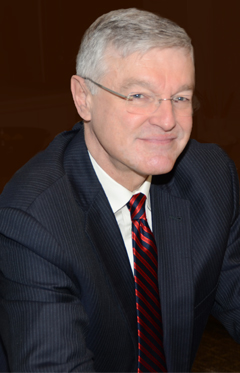Academic medical centers scrambling for research dollars should look beyond the limited resources of the NIH to other funding sources – in particular, the Department of Defense.
That’s the advice of Col. (Ret.) Ronald K. Poropatich, MD, executive director for the Center for Military Medicine Research at the University of Pittsburgh, who visited the Arizona Health Sciences Center earlier this year as the inaugural Arizona Telemedicine Program Visiting Professor.
“It’s very clear that for academic medicine to survive, we have to find other revenue streams,” said Dr. Poropatich, who is an expert on Department of Defense (DOD) extramural research funding. He also is former deputy director of the U.S. Army’s Telemedicine and Advanced Technology Research Center (TATRC), and former president of the American Telemedicine Association.
Traditional funding sources in addition to the National Institutes of Health include other branches of Health and Human Services, or the National Science Foundation. But the Department of Defense is another source that should be tapped, Dr. Poropatich said.
“What the military wants is products and solutions that will fill in their capability gaps,” he said. The need for innovation extends from point of injury on the battlefield to the combat support hospital, the on-flight care during transport back to the U.S, and to post-hospital rehabilitation and psychological support, he said.
Driving the DOD’s push for more medical R and D is the changing reality of combat injuries, Dr. Poropatich said.
 Even for those with life-threatening injuries, “If you get to a Level 3 Combat Support Hospital alive, you have a 90 percent chance of survival. Ninety percent. We’ve never had that level of success before.”
Even for those with life-threatening injuries, “If you get to a Level 3 Combat Support Hospital alive, you have a 90 percent chance of survival. Ninety percent. We’ve never had that level of success before.”
And the injuries themselves have changed. In Iraq and Afghanistan, chest wounds have been less common than in the Civil War, because of body armor. The worst injuries are resulting from ground-level IEDs – improvised explosive devices – typically resulting in polytrauma. Most injuries are orthopedic, but head and neck, and genitourinary traumas are among the most common.
Academic medical researchers should also keep in mind the need for new training modalities, Dr. Poropatich said.
“Training the medic at point of injury – what are they going to take with them and use immediately to improve survival,” he said. “And specialty surgical training – how do I train a general surgeon to do very complex genitourinary operations. How do I train an ob-gyn surgeon to do an abdominal surgery that he or she may not be familiar with. New ways to do pain control on the battlefield. All these are important.”
Researchers also need to be familiar with the DOD itself – its vocabulary and the agencies within the DOD, Dr. Poropatich said. The Defense Advanced Research Projects Agency (DARPA) is key. It originated in 1958 in response to Sputnik, and now has an annual research budget of $3 billion, Dr. Poropatich said. In April of this year, DARPA launched the Biological Technologies Office to “merge biology, engineering and computer science to harness the power of natural systems for national security,” according to its announcement.
DARPA also funds a Young Faculty Award program, which in 2012 gave $12 million to 40 research projects, out of 400 submitted. The grants were for $300,000 a year for two years.
Dr. Poropatich encourages researchers to contact DOD program managers with their ideas and questions before submitting a formal proposal.
“You have to understand the unique needs of DOD medical research,” he said. “Remember, you need to fill the capability gaps. And what’s very important to keep in mind is those solutions are not just about what’s important on the battlefield, but also what’s important in the peacetime setting.
“Figure out what we need,” he said. “Do the research. Get it out there. Commercialize it. And keep it moving.
Dr. Poropatich’s talk was part of a full day of meetings and discussions with researchers from across the UA campus, sponsored by the Arizona Telemedicine Program.
Allan Hamilton, MD, director of the Arizona Simulation Technology and Education Center (ASTEC) at the UA College of Medicine, said Dr. Poropatich’s talk was vital for researchers in medical and related fields.
“The military is becoming front and center in terms of funding opportunities,” Dr. Hamilton said. “What (Dr. Poropatich) is saying is there is a huge overlap between what we want to investigate as a research university and what the military wants to investigate.”
Ana Maria Lopez, MD, medical director of the Arizona Telemedicine Program, directs the Visiting Professor program.
“We want to have the Arizona Telemedicine Program serve as a resource to bring national figures to our campus and help nurture collaboration within the university and outside the university,” Dr. Lopez said.
“That interaction gives people a larger sense of what’s possible, and it gives them another lens through which to see their own work.”
For more information regarding DOD medical research funding opportunities, please visit http://cdmrp.army.mil/funding/

